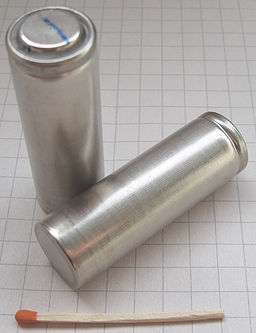
Today, batteries are commonplace. They’re in phones, cars, computers,
clocks, watches, pacemakers, and many other devices. But while people
assume batteries are a fairly recent invention, they’re actually not. A
tomb discovered in Baghdad contains what may be the first type of
battery, and it’s been dated as being 2,000 years old! Experts even
believe that the Sumerians might have used batteries as far
back as 2500 BC, although no surviving Sumerian batteries have been
found.
The modern battery has its roots in a design by Alessandro Volta in the
early 1800s, although it didn’t hold much of a charge. The idea was
refined over the years by John Frederich Daniell, Gaston Plante, Georges
Leclanche, and Camille Faure. Thomas Edison created an alkaline cell
that made use of positive and negative materials in the early 1900s, and
in 1949, the first true commercial alkaline battery was created. Since
then, the battery has shrunk, new materials have been incorporated, and
batteries have been made to last longer and store more energy. They’re
so prevalent now that people use batteries every day without even
realizing it. The battery also continues to evolve, and it’s likely to
become even smaller and more powerful in the future
- Battery Applications – Arranged by amount of energy produced
- Types of Batteries – The different types and their applications
- Batteries: The Definitive Guide – A Guide to Different Types of Batteries
- Battery Chargers – A Guide to Battery Chargers
Uses of the Battery Throughout History
What was that 2,000 year old battery actually used for? We may never
know, but we do know that batteries have been used throughout history in
a number of different ways. John Frederic Daniell’s battery, the first
practical version of the device, was used in telegraphs. A variant of
the Daniell cell, the gravity cell, was actually still used in some
telegraph way stations as recently as the 1950s.
In 1859, Gaston Plante created a lead-acid battery. This battery was
fairly heavy and rather bulky when compared to some others, but it had a
few advantages: it could produce very large currents of power in surges,
plus it could power multiple circuits at once. Today, automobile and
forklift batteries are still based on Plante’s lead-acid battery, and
the basic design hasn’t changed.
The battery created by Georges Leclanche has been used to power
telephones and in other telegraphy applications, and the dry cell
zinc-carbon battery created by Carl Gassner that built upon Leclanche’s
battery is also still manufactured today.
Batteries have been used to power many different things: telegraphs,
cars, watches, household appliances, and even space exploration probes
like the Mars rover. Because electricity is a clean form of energy, more
and more people are looking to batteries to replace things that run
on gasoline and other types of fossil fuels.
- The Baghdad Battery – The Wiki on the 2,000 year old battery
- The History of the Battery – From beginning to the formation of Duracell
- The Pacemaker – This application of the battery is literally a life saver
- Lithium and Nickel Batteries – These types of batteries can be found in cell phones
The Batteries of the Future
This focus on new, green energy means we’re likely to see the battery industry continue to change and grow. Things like electric cars already incorporate new types of technology to make their batteries last longer, while NASA makes use of batteries that can power its space probes for years while refueling by collecting solar energy.
But one of the most interesting advancements in battery technology was announced on May 1, 2015, when Tesla unveiled its newest battery products. Known for their advanced electric cars, Tesla has been a leader in the battery industry for the past decade or so. But this new battery, called the Tesla Powerwall, isn’t designed for cars. Instead, it’s a battery that, if all goes as planned, will be able to power a home.
These batteries are designed to store either 7 or 10 kilowatt-hours, depending on which size is installed. While most people use an average of around 30 kilowatt-hours a day, that includes the use of heavy appliances like washing machines and dishwashers. If a family were to use only the basics, it’s very possible that one of these Powerwall batteries could run a house for a full day. It may not make it possible to go fully off the grid yet, but these batteries could be combined with solar energy cells to greatly reduce the dependency on power produced by the electric company.
- In Search of the Perfect Battery – How companies are working on new batteries for electric cars
- The Tesla Powerwall – Information on this new battery
- What’s the Future of Batteries? – A look at where the industry could be going
- Potential EV/Hybrid Battery Breakthroughs – A gallery of potential new battery technologies
- How Scientists Plan to Spark Future Battery Breakthroughs – What might break about the next major battery revolution?
